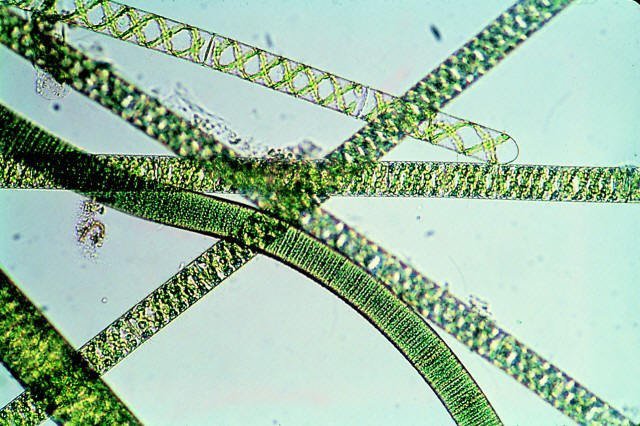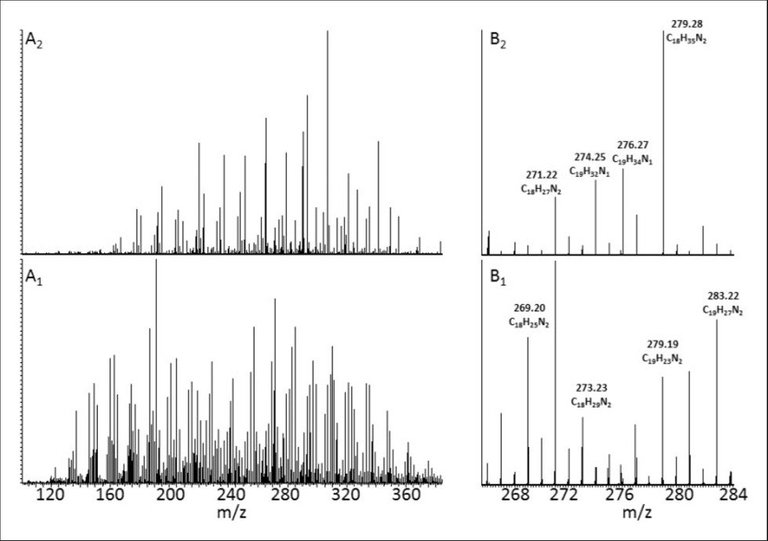Researchers have shown that biofuel in composition has little to do with oil, but it has something in common with green.

Scientists have determined the composition of biofuel obtained from microalgae Spirulina platensis, using high-resolution mass spectrometry. Two biofuel fractions were studied, which are obtained after a mass of algae is treated by a special method. The study is published in the journal European Journal of Mass Spectrometry. The work was carried out by a group of scientists from Skoltekh, the Institute of Energy Problems of Chemical Physics of the Russian Academy of Sciences, the Institute of Biochemical Physics. Emanuel RAS, Joint Institute for High Temperatures of RAS, Moscow State University and Moscow Institute of Physics and Technology.
Algae as a salvation of ecology
Biofuel, as an alternative source of energy, is of particular interest for study, because it would help solve such problems as depletion of oil reserves and global warming. Unlike oil, biofuel is produced from renewable natural resources, and when it is burned, less greenhouse gases are released. Brazil, for example, already provides 40% of its needs with biofuels. As a raw material for biofuels, crops and other plants are used. However, in this case it is necessary to occupy a fertile land that could instead feed people. Promising raw materials for biofuel are marine microalgae, which do not require either pure water or land. Algae actively absorb carbon dioxide, which means that their use is really useful for reducing the greenhouse effect. Fuel from microalgae is called third generation biofuel, and active work is currently under way to produce it.
Biofuel Recipe
If we know the composition of biofuels, we can improve the process of its production. The initial techniques for producing fuel from algal mass were energetically unfavorable, as much energy was spent on drying algae, which contained a lot of water. For commercial use, a new, more efficient method was needed. And such a method was invented - this is the so-called hydrothermal liquefaction: the wet biomass is heated to a temperature of more than 300 ℃, compressed by a pressure of 200 atm and the output is fuel. Approximately the same principle operates in nature, when under the influence of high temperatures and high pressure in the bowels of the Earth, oil is formed, but this happens more quickly in the reactor. As a result, two fractions are obtained: liquid biofuel and a thick mass that remains in the reactor. These are mixtures consisting of thousands of individual components, and mass spectrometry is the best way to determine their composition.
Mass spectrometry
Mass spectrometry is a method of investigation by means of which the composition of a substance can be determined. The method is based on the fact that in an electrical and / or magnetic field different compounds behave differently, depending on their mass-charge ratio m / z. The output is a mass spectrum - a graph with intensity peaks, where each peak has its own m / z value.
With the help of mass spectrometry, scientists have studied biofuel derived from algae Spirulina platensis. In the process of hydrothermal liquefaction, all substances with a boiling point of less than 300 degrees leave the reactor in the form of gas and are cooled in a special container. Thus, a liquid fraction is obtained, and a solid fraction remains in the reactor. Mass spectrometric analysis showed that both fractions contain most of the substances that have N and N2 in the composition, but the components of the solid fraction are more diverse and differ in properties from the components of the liquid fraction. The substances found in biofuel had nothing to do with substances that are contained in conventional crude oil, although they are combustible. Mass spectrometry allows you to know only the molecular formulas of substances (for example, C18H35N2). To obtain some information on the structure of molecules, the researchers used the method of replacing hydrogen with deuterium.
Replacement of hydrogen by deuterium
When hydrogen is replaced by deuterium, the ion mass becomes larger and the peak in the spectrum shifts. By whether the peak has shifted or not, scientists determine where the hydrogen was in the molecule. However, not any hydrogen will give its place to deuterium, more precisely, not any place hydrogen can release.
Before you start the molecules in the mass analyzer, they need to be charged, otherwise the electromagnetic field on them will not work. In ordinary molecules, the charge is z = 0, in which the number of protons is equal to the number of electrons. And if, for example, a proton is attached to a molecule (a particle with charge +1), then it becomes an ion with a charge z = 1. The process of converting molecules into ions is called ionization.
Before starting the mass analyzer, the sample molecules are ionized. In this case, neutral compounds were added with protons, and they turned into positive ions. The attached proton is easily replaced with a deuteron, but it turned out that in some components of biofuel no replacement occurs. Scientists have realized this by the intensity of the shifted peak, which is obtained when replacing. In conventional oil, the displaced peak had the same intensity as the unshifted peak, which means that the replacement occurred completely. In the case of biofuel, the intensity of the biased peak was five times less. This means that under one peak there are several connections and not all of them have an attached hydrogen, instead of which deuterium could stand. If the substances do not lend themselves to ionization, then they are already positive ions and in this form are contained in biofuel. These substances are similar to some colorants, such as, for example, brilliant green, which is part of the green.
In the nucleus of deuterium, or heavy hydrogen, in addition to a proton, there is a neutron that affects the mass, but not the charge

Yevgeny Nikolaev, Corresponding Member of the Russian Academy of Sciences, Professor Skoltekh, Head of the Laboratory of Ion and Molecular Physics, Moscow Institute of Physics and Technology commented: "Investigation of the products of hydrothermal liquefaction of microalgae by mass spectrometry is important for increasing the efficiency of biofuel production. Further work should be focused on the use of algae varieties with the highest possible lipid content and the creation of such varieties using genetic modification. So we can choose from them the most effective raw materials for biofuels. "
Very informative content.As our oil reserves are depleting we should have some alternative fuel for keep moving.Bio fuel will also significantly reduce the green house effect.
Biofuel from algae thats really cool ...resteeming this post
Very informative, very interesting, very nice. UPVOTED.
Tht is better. BIO FUEL... but i hope they will start using that for the better future...